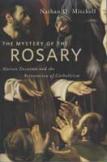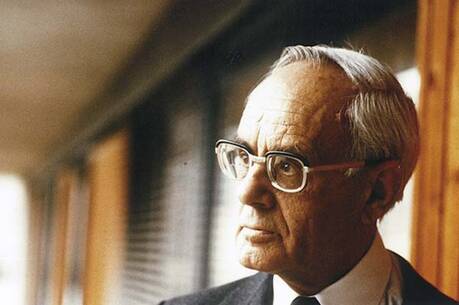Beads of Power
It is said that on one occasion a reporter from a national newsmagazine went to a Jesuit residence to interview John Courtney Murray, S.J. The reporter arrived unexpectedly early and found him walking in the garden saying the rosary. An embarrassed Father Murray hastily shoved the rosary into his pocket because he did not want to make a display of his piety. Whether the story is true or ben trovato, it illustrates nicely one of the themes of this book, the perennial appeal of the rosary to high and low alike, both to distinguished theologians like Murray and to countless other Christians who never cracked a book because they were illiterate. The author notes without comment the popularity of the rosary today with people as diverse as Garry Wills and Mother Angelica.
The use of beads to facilitate prayer is older than Christianity itself and is not confined to Christians today. Over a century ago Catholic scholars (fortunately, one of them a German Dominican) demolished the venerable legend that Mary personally gave the rosary to St. Dominic. Nathan D. Mitchell, a professor of theology at the University of Notre Dame and associate director of the Notre Dame Center for Liturgy, offers only a cursory survey of the shadowy late medieval origins of the rosary in order to concentrate on the vital role that the rosary played in the renewal of Catholicism in the aftermath of the Protestant Reformation.
Mitchell draws upon contemporary historical scholarship, as well as the pioneering work of an older generation of historians like H. Outram-Evennett and John Bossy, to demonstrate the positive and innovative side of the Counter-Reformation, an aspect that he says came to the surface especially in the quarter century between 1585 and 1610. Although he never uses the word, he emphasizes the populist side of the Counter-Reformation that found expression in the preaching of St. Philip Neri and the madonnas of Caravaggio, “where saints, nobles, working mothers and toddlers, lazzaroni with dirty feet and grasping hands, all are drawn into the orbit of Mary and the Christ child.”
The author places the revalorization of the rosary in this context, since it was in Counter-Reformation Rome, if not earlier, that the telling of the beads was associated with meditation on the great events in salvation history. Moreover, by linking the mysteries of the rosary with the Ignatian meditative practice of considering oneself a participant in the biblical events, the rosary became an interactive form of prayer. In Mitchell’s words, the rosary “was no longer an exercise in ‘thinking about’ divine mysteries but of participating directly in them.”
Mitchell is too honest a scholar to ignore a darker side of the development of Marian piety associated with the rosary. At the naval battle of Lepanto in 1571, the largest naval battle in history to that date, the Spanish and Venetian fleets won a decisive victory over the Turks. The Christian triumph was widely attributed by Catholics to the intercession of Mary, who had responded to the prayers of the faithful (and of a Dominican pope, Pius V), who were praying the rosary during the battle. The unfortunate result was the intensification of a cult of Mary not only as gentle mother, but also as “warrior queen.” The feast of the Holy Rosary, still celebrated on Oct. 7, which did so much to promote the use of the rosary, was originally called the feast of Our Lady of Victory.
The author rejects the notion that the popularity of the rosary in early modern Europe was confined largely to the rural poor and disdained by the urban elites. On the contrary, he notes the proliferation of parish-based rosary confraternities in Rome and other cities. They were characterized by their inclusivity, the equal participation of men and women and a devotional life that overflowed into a concern for the poor. Nor was the rosary regarded as a strictly private or personal prayer. Thanks in part to the rosary confraternities, it was often linked to the public prayer of the church, and in the Dominican church of Santa Maria sopra Minerva in Rome it was recited in choir like one of the liturgical hours. Mitchell also speculates that the popularity of the rosary was due in part to the fact that it gave devout Catholics an opportunity to “customize” their prayers in a way that was increasingly difficult to do in the Tridentine liturgy.
During the centuries of the penal era in England, Ireland and Scotland, when Catholics were deprived of churches and their priests risked their lives to celebrate the Eucharist for them, the rosary acquired special significance both as a means of sanctification and as a badge of Catholic identity. Scottish Catholics cherished the memory of the martyr St. John Ogilvie, who tossed his rosary from the scaffold to a group of Catholics just before his execution in Edinburgh in 1615. Later in the century the Church of Scotland began an intensive search for “Papist beids.”
There are fashions in devotion just as in many aspects of secular life. Today where, besides Africa, would one find a novena to St. Rita, whose cult was so popular a century ago? But Mary is different, and because of Mary the rosary is different. While there is no evidence that the origins of the rosary can be traced to direct divine intervention or even ecclesiastical decrees, Mitchell demonstrates that it can be traced to “popular, vernacular devotion from the ground up,” and that, at least from the 15th century, when it was combined with private meditation, it “gave scope to the human imagination in ways that the church’s more closely regulated rituals did not.” He has effectively drawn from a wide range of historical, literary, artistic and liturgical sources to trace the evolution of the rosary over the past 500 years and explain its enduring popularity.
This article also appeared in print, under the headline “Beads of Power,” in the January 4, 2010, issue.








